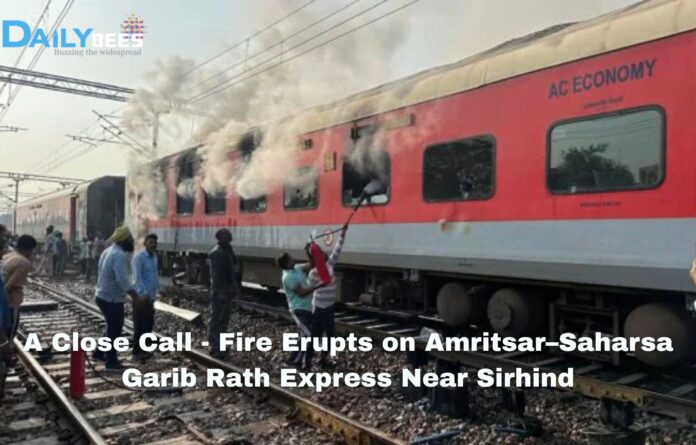On Saturday morning, around 7:30 a.m., a fire broke out in an air-conditioned coach of the Amritsar to Saharsa Garib Rath Express (Train number 12204) as it approached Sirhind railway station in Fatehgarh Sahib district, Punjab.
Smoke was detected coming from coach G-19, prompting a passenger to pull the emergency chain. The train was brought to a stop immediately.
Table of Contents
Evacuation & response
Passengers in the affected coach were quickly evacuated by railway and GRP (Government Railway Police) officials and moved into other coaches. Two adjacent coaches also sustained minor damage. Fire-tenders reached the scene and brought the blaze under control before it could spread further.
Casualties & damage
Fortunately, there were no major casualties. One woman, aged 32, sustained minor burn injuries and was taken to the Civil Hospital in Fatehgarh Sahib for treatment.
The three involved coaches—the one where fire broke out and two adjacent ones—were detached from the train to prevent further risk.
What happens next?
Railway authorities say the cause of the fire is under investigation. The train remains stationary near Sirhind as safety checks are carried out.
Officials emphasize that the swift response averted what could have been a “major mishap”.
Context and significance
The Garib Rath series is a budget AC-3 tier train service by Indian Railways aimed at providing air-conditioned travel at more affordable fares. The Amritsar–Saharsa Garib Rath connects key northern and eastern regions, covering Punjab, Haryana, and Bihar.
Given the large number of long-distance travellers using such trains, a fire in an air-conditioned coach is especially concerning, because:
- AC coaches involve integrated electrical and air-conditioning systems, increasing fire risk if equipment fails.
- Fires can escalate quickly in enclosed coach environments.
- Evacuation is more complex when trains are moving, especially at speeds or in remote sections.
In this incident, the fact that the fire was detected early, the chain pulled, and evacuation executed swiftly, all contributed to preventing greater harm.
What went right and what needs review
What went right:
- Passengers or staff noticed smoke and acted quickly (pulling the alarm chain) which is a critical first step.
- The train was brought to a halt before the situation worsened.
- Evacuation from the affected coach and movement of passengers to safe coaches happened smoothly.
- Firefighting services were mobilised and the threat contained.
What needs review:
- The cause of the fire remains unknown; identifying whether it was electrical failure, HVAC malfunction, external spark or human error is essential.
- Why did the smoke detection or alarm not prompt earlier action from staff? There may be gaps in monitoring or early warning systems.
- Were the fire-safety mechanisms (extinguishers, coach fire-retardant materials, emergency exits) in optimal condition?
- How effective was communication to passengers during evacuation? Long-distance night trains may have sleeping passengers who may be disoriented.
- The train had to be stationed for checks—this suggests potential delays for a large number of travellers; systems need to account for minimal disruption while ensuring safety.
Rail safety in India: broader perspective
Fires on trains, while less common than derailments, are among the most feared incidents because they can trap passengers in confined spaces and spread rapidly. Indian Railways has in recent years taken several initiatives:
- Phasing in of LHB (Linke-Hofmann-Busch) coaches that are fire-resistant and have improved safety features.
- Upgrading old wiring, AC systems, and fire-detection systems.
- Regional drills for firefighting response and evacuation at stations and along routes.
- Clearer protocols for passengers on how to react in emergencies (pulling alarm chains, moving to safe coaches, etc.).
Nevertheless, this incident serves as a reminder that even major routes—one carrying a long-distance premium AC train remains vulnerable to sudden fire risks.
Voices from the scene
Passengers and local responders described tense moments after the smoke was seen. According to reports:
“We heard crackling and then saw smoke coming from the roof of the coach. Suddenly the chain was pulled and in minutes the train stopped. We moved to the next coach and the staff was directing us. Passenger on the train reported the same.
Station and police officials said swift coordination between the GRP, station staff and fire-services made the difference.
The route and timing: why this location mattered
The incident took place near Sirhind station in Punjab, as the train was nearing the end of the Ludhiana – Ambala section. Because the fire occurred while the train was still in a relatively busy railway zone (compared to remote stretches), the chances of prompt response were higher.
Moreover, the time—early morning—meant many passengers were awake or in transit; miracles often happen when incidents strike during deep night hours when evacuation is more difficult.
Impact on passengers and services
- Immediate disruption: The train had to be stopped, coaches separated and safety checks done, likely causing delays for passengers en route to Saharsa.
- Psychological impact: Though no major injuries occurred, the scare of fire in a moving train is significant, and trust in safety systems may be shaken.
- Operational cost: Damaged coaches will require inspection, repair or replacement, affecting rail operations and scheduling.
- Safety audit trigger: The incident is likely to trigger a fresh audit of AC coach safety across Garib Rath trains and long-distance AC services.
What passengers should do to stay safe
For travellers on long-distance AC trains, this incident highlights a few practical steps:
- Familiarise yourself with emergency procedures: Locate the alarm chain/handle. Know how to respond if directed by staff.
- Note the coach number: In this case coach G-19 was affected; knowing your coach number helps in evacuation.
- Keep personal items accessible: Valuables, medicines, phone should ideally be within reach. In an emergency, you’ll evacuate fast.
- Don’t panic, follow instructions: Staff are trained for emergencies; following their direction helps orderly evacuation.
- Report early signs: If you spot smoke, spark or smell something burning, alert staff immediately. Early detection saves lives.
Looking ahead: key questions for Indian Railways
- What was the cause of the fire? Until this is established, similar risks remain unresolved.
- Are all AC coaches across Garib Rath services equipped with functioning fire-detection systems?
- What percentage of coaches still uses older wiring or equipment prone to short-circuit or malfunction?
- Can passenger awareness programmes be increased? More travellers need to know how to act quickly (pull chain, move coaches, etc.).
- What are the maintenance intervals for fire-safety equipment and how rigorously enforced are they?
- In the longer term, will Indian Railways accelerate replacement of older coach stock with newer, safer ones for long-distance AC services?
Conclusion
What could easily have turned into a major tragedy was averted thanks to swift detection, swift action by passengers and staff, and rapid firefighting response near Sirhind. While this incident ends without loss of life—which must be the immediate relief—the question now shifts to ensuring that the safety systems which worked this time are robust enough to work every time.
For the thousands of passengers who travel daily on AC long-distance trains such as the Garib Rath series, this event is a reminder that safety is collective: infrastructure, maintenance, staff training and passenger vigilance together determine outcomes. As investigations proceed, Indian Railways will have to demonstrate that lessons are learned, vulnerabilities are closed, and passengers can trust that journeys remain safe even when the unexpected strikes.













